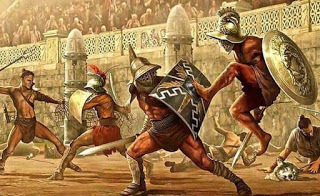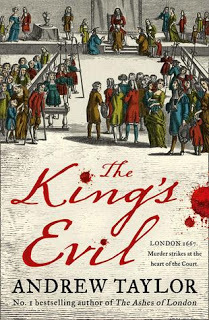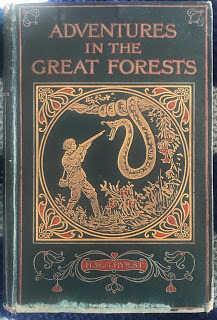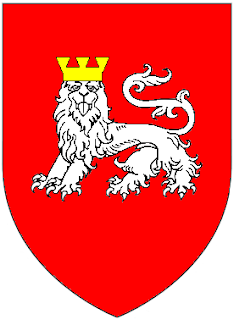Rupert Matthews's Blog, page 11
April 29, 2020
Not everything that looks like a cat is a cat
 Not everything that looks like a cat is a cat
Not everything that looks like a cat is a cat The Thylacosmilus looks very like a sabre-tooth cat. It has a cat-shaped body and long stabbing teeth to kill prey. However, it is a marsupial hunter which is more closely related to the kangaroo than it is to cats. Thylacosmilus lived in South America about 4 million years ago.

Published on April 29, 2020 03:27
Julius Caesar and the Gladiators
 Julius Caesar borrowed money to buy his gladiators
Julius Caesar borrowed money to buy his gladiators Julius Caesar rose to become the dictator of the Roman Empire. Early in his career he staged spectacular games to win votes in elections. But Caesar was too poor to afford to pay the bills, so he borrowed money from richer men. When he won the elections, Caesar repaid the men with favours and titles.
Caesar’s gladiators fought in silver armour
In 65BC, Julius Caesar staged the funeral games for his father, who had died 20 years earlier. Caesar was standing for election to be Chief Priest of Rome. To make his games even more special, Caesar dressed his 640 gladiators in armour made of solid silver.
Caesar brought war elephants to Rome
In 46BC Julius Caesar celebrated a victory in North Africa by staging gladiatorial games in Rome. Among the prisoners of war forced to fight in the arena were 40 war elephants, together with the men trained to fight from them.
Caesar turned senators into gladiators
On one occasion Caesar forced two rich noblemen to fight in the arena. The two men had been sentenced to death by a court, but Caesar ordered that the man who killed the other in the arena could go free.
Caesar’s final show was too big for the arena
The games staged by Julius Caesar when he wanted to become dictator of Rome were the grandest ever held. After several weeks of shows, games and feasts, the final day saw a fight between two armies of 500 infantry and 30 cavalry. The battle was so large it had to be held in the enormous chariot race course.

Published on April 29, 2020 03:24
April 25, 2020
BOOK REVIEW - Milestones to Disaster

The five volumes of Churchill's memoirs of the Second World War have been sitting on my bookshelf staring at me for some years now. I thought that lockdown was a good opportunity to read them.
I have read books about Churchill, but this is the first book by him that I have read. Despite its rather daunting size and subject matter, I found this to be a very readable book. No wonder Churchill was such a successful journalist. His writing style is lucid, light and gripping. It keeps you bounding along from one anecdote to the next, one memorable quote to the next and one pen portrait of a person to the next. Gripping stuff.
As well as being a good read, this book takes a very personal view of the build up to war. It really is about Churchill's actions, words and views as the world slides towards conflict. He highlights issues and events that were important to him at the time, not necessarily those that later historians think were important in hindsight. A unique persepctive. It must be said that I did not realise the way that Churchill, as an ex-cabinet minister and scion of an aristocratic family, had such wide ranging access to government staff and papers. It puts a different gloss on his warnings of German aims and rearmaments. Of course, Churchill comes out of all this very well - but I suppose he would as he wrote the book. On the other hand he does admit his errors when he makes them.
Despite having gone over this ground many times, I learned new things. I did not appreciate, for instance, that Stalin had tried to come to terms with the UK and France against Germany before chucking in his hand with Hitler in 1939. I did not realise the vacillations of Mussolini's policy changes, and had no idea that there were reasons other than evil fascist empire-building for his invasion of Abyssinia.
I would recommend this book to anyone interested in the period, in Churchill or in history in general.

Published on April 25, 2020 04:36
April 20, 2020
BOOK REVIEW - The King's Evil by Andrew Taylor

Yet another great read from Andrew Taylor. I know that I am a history buff, but I really enjoy reading his historic novels. He manages to capture the atmosphere of the Restoration period remarkably well and includes a lot of great period touches without overdoing it in terms of education or explanation.
In this novel he concentrates on The King's Evil [now known as scrofula] a disease that it was believed the touch of the monarch's hand accompanied by prayers and church ritual could cure. That is a key plot device [don't worry I won't do spoilers here]. That works very well not only because everyone in the novel believes that the king's touch will work, but also because the plotters take advantage of that belief [which they share] to further their cunning schemes.
It is the third in the series features James Marwood & Catherine Lovett. While it builds on the storyline of the previous two, you don't really need to have read them to enjoy this book. The plotlines that continue are explained as you go along so that is all fine. These principle characters, and the others, are all well drawn. he has taken pains to make even minor characters credible as human beings.
Mind you, I had pretty much worked out the surprise ending by about half way through. Either I am getting used to how Taylor weaves his plots, or it was not as fiendishly complex as the other two that I have read.
All in all an excellent historic novel and whodunnit. Read it sooner rather than later.

Published on April 20, 2020 02:26
April 14, 2020
BOOK REVIEW - The Hitchhiker's Guide to the Galaxy

Great book!
I'm old enough to just about remember when the radio series first went out. It was an instant cult classic among the boys at my school. We would eagerly listen to it on the radio, then discuss it next day at school. I bought the book as soon as it came out and read it voraciously. At some point over the years and the various home moves I lost my original copy.
I bought it again last year as my eldest daughter was asking about it. She read it and loved it, so we got the entire trilogy [in 5 parts]. I have just re-read this first volume. It is just as amusing as I remember it. Of course, it has dated a bit over the years - nobody today thinks that digital watches are a neat idea, while nobody in the book has a mobile phone. Despite this the characters are just as engaging, the storyline just as nonsensical and the jokes just as funny.
Go and buy it.

Published on April 14, 2020 01:42
April 13, 2020
BOOK REVIEW - Adventures in the Great Forests

Well, I enjoyed this book very much. It is over a hundred years old and is talking about events going back 150 years before that. Unavoidably it is very dated and some modern readers might be put off by some of the attitudes reflected here.
For instance wanting to shoot wild animals is considered a perfectly valid reason to travel through remote forests. That said, these accounts are straight from people who went to wild places while they were still in their pristine state so they reflect very much what they were like.
It also includes accounts of travellers encounters with the locals. Most of these are fairly straightforward, though they do show just how difficult travel was and how remote placed could be before modern roads or railways came through. Some are inadvertently amusing - such as the time when a pair of Brits entered a Caucasus village where they did not speak a word of the local language. They found what they thought was an inn of some kind and entered trying to buy some food and drink. Clearly there was some kind of massive misunderstanding and our travellers had to leave hurriedly when it became obvious that they had caused offence. Reading it a second time I wondered if they had walked in on a wedding or family party of some kind, not an inn at all.
As with so many of these old books, it is absolutely fascinating but you do need to read it with an open mind and an appreciation of the attitudes of the time.
If you see a copy in a second hand bookshop some time, it worth a few pennies of your money.

Published on April 13, 2020 03:21
April 6, 2020
Book Review - The Deerslayer by Fenimore Cooper

I enjoyed reading this book - with a few caveats - but the ending was very disappointing. I'm going to talk about the issues, so take this as a spoiler alert.
The book was written getting on for 200 years ago and so it reads as very old fashioned to modern tastes. Just to take a couple of examples. There is very little dialogue. We are often told by the narrator what a person said rather than reading the actual dialogue. And the paragraphs can be very long. One paragraph ran for a page and a half. This is a part with the style back then. There is loads of descriptive writing, some of which is very good. We get lots of writing about the landscape, the clothing, the physical appearance of the people and so forth. Before radio and TV, I guess people wanted to read this sort of thing. After all, most readers would not have visited the New York forests and would not have seen them on tv or movies, so this sort of descriptive writing was needed. Today it can drag on a bit and get in the way of the story.
That said, it is a good action tale that jogs along quite nicely with enough incident to keep the reader happy. And the author really does recreate the forests and frontier society of the time very well. I'm no expert on the Huron, Iroquois or the Delaware tribes, but the descriptions of their society and lifestyles are at least credible and fascinating. Assuming the author knows what he is talking about it is a real education.
But I did have a few issues with the book.
Take the character of Hetty. When we first meet her the narrator tells us that she is "feeble-minded", and at least a dozen times we are reminded that she is "simple" or "not normal". Well, fair enough in the terminology of the time I suppose. But at no point in her dialogue or actions does she come across as being "feeble-minded". She carries on conversations perfectly well and carries out all sorts of activities on her own without any problems.
There is also a lot of inconsistency in the way events of the tale. An example of this is the size of the Huron raiding party. At one point Harry and Hutter set off to ambush it. There are only two of them, so we must assume that there are not many Huron warriors. A few chapters later the Huron camp is described and it is now clear that there are around 60 or 70 warriors. Later still there seem to be only 20 or 30 warriors. What is going on? Maybe the raiding party splits up and then recombines, but we are not told that.
But my real problem is with the ending.
It is almost as if the author had planned a longer book, but then lost interest and decided to wrap it up in as few pages as possible. He uses a crass deus ex machina to achieve this. But even on its own terms, it does not really work.
The fascinating battle of wits between Hawkeye and the leader of the Hurons had been developing for over half the novel. Clearly the two were developing a respect for each other's gifts and skills that looked as if it might develop into a way of resolving the conflict. No chance. The Huron chief is shot dead.
Similarly the slowly developing mystery of the origins of the two Hutton girls is never really resolved. We learn snippets as we go along that point to the suspicion that their mother [Who dies before the story begins] came from a grand and wealthy family in New York City before falling from grace and ending up married to a backwoodsman like Hutter. Again, this might have developed further to resolve the issue of what was going to happen to the girls after their father is killed. No chance. Hetty gets shot dead and Judith walks off up a path and out of the book. I could go on, but you get the idea. There are lots of loose ends left dangling.
What had been an enjoyable adventure story with a number of subplots twisting and turning along the way ended very unsatisfactorily.
A shame.

Published on April 06, 2020 04:00
April 2, 2020
Archimedes of Syracuse (c.287bc-211bc)

The great Greek scholar, scientist and inventor Archimedes of Syracuse (c.287bc-211bc) is best known today for his scientific works, but in his lifetime he was much more admired as an inventor of the most deadly weapons of his age.
Archimedes was born in Syracuse, then a wealthy Greek colony on the island of Sicily, to a noble family that was probably related to the kings of the city. As a young man he travelled to Alexandria in Egypt, then the centre of intellectual activity in the Greek world and site of the famous Library of Alexandria - the largest in the world. At Alexandria, Archimedes won great fame for working out how to calculate the volume of a cone - something that had so far eluded even the finest mathematicians. He went on to develop what became known as the Archimedes Screw, a simple pumping device. The screw consists of an open-ended cylinder containing a tightly fitting spiral connected to a handle. If the bottom of the cylinder is placed in water at an angle and the spiral turned with the handle, water will be trapped in the threads of the spiral and pulled up to the top of the cylinder. This makes a much more effective pump than those then in use in Egypt.
Returning to Syracuse, Archimedes was hired by the Romans to devise a reliable apparatus for measuring distances along roads. Archimedes produced a cart that had mounted on it a complex system of gears that turned an indicator dial once for every mile the cart travelled. This device was used to erect milestones on Roman roads across Europe and was still in use 300 years later.
In 215bc King Hieron of Syracuse died and was succeeded by his son Gelon who went to war against Rome. The Romans began a siege of Syracuse, but soon found themselves held off by a series of weapons invented by Archimedes. One of these was a catapult that had an automatic loading system, allowing it to shoot three times as quickly as a conventional weapon. A second was a system of mirrors that could concentrate the rays of the sun and set fire to ship’s sails at a distance of over 300 yards. The most impressive of the machines, however, was the dreaded “Claw”. This device consisted of a massive wooden beam that could be pushed out over the top of the city walls. From the outer end dangled strong cables attached to a claw-shaped grappling hook. Inside the city was a complex system of pulleys and levers that allowed the beam to be swung from side to side. Once the grappling hook caught on a Roman ship, the pulleys were worked by teams of oxen to pull the interior end of the beam down, thus lifting the Roman ship up out of the water. When the ship had been pulled up far enough it was suddenly let go to crash back into the sea with terrific force, sinking the ship and killing most of those on board. The Romans did not know what had hit them. Prudently they pulled back from the harbour.
Due largely to Archimedes work the siege dragged on. Finally in 210bc the Roman managed to break through the city walls of Syracuse. The Roman commander, Marcellus, gave orders that Archimedes was to be spared. But when the Roman soldiers burst into his house and ordered him to follow them, Archimedes was so engrossed in a complex mathematical problem that he ignored them. The angry soldiers killed him. Marcellus erected a fine tomb for Archimedes consisting of a cylinder mounted on a sphere.
Quote:
“Give me somewhere to stand and I can move the Earth” Archimedes in a lecture on levers c.230bc

Published on April 02, 2020 10:12
The Battle of Nibley Green, Gloucestershire, 1470
 The Lisle coat of arms.
The Lisle coat of arms. On a spring morning in 1470 the peace of Gloucestershire was shattered by the sounds of battle. The Wars of the Roses had come to this peaceful corner of southwestern England in spectacular and bloody fashion. But the battle fought at Nibley Green had very little to do with the dispute between the House of York and the House of Lancaster. The fate of the throne was not at issue at Nibley Green, nor were the underlying social tensions between the ancient landed aristocracy and newly rich mercantile classes that lurked behind the dynastic dispute. No, the fight at Nibley Green might have been dressed up as a principled stand over support for the rightful king (whoever he was) but in reality it was a brutal affair fought to settle a local dispute between local aristocrats and local magnates. Nibley Green has, perhaps rightly, been identified as the last of the private battles that had been such a feature of medieval England. As such it reveals much about late medieval society, and the ways in which men went about fighting battles in that bloody era.
You can buy the book HERE


Published on April 02, 2020 09:55
The Rout of the Lanastrians at the Battle of Towton
 As the Lancasatrian right wing collapsed into a mass of fleeing fugitives, Faucunberg sought to move his men round to attack the flank of the men commanded by Trollope. Some Yorkists could not resist the temptation to pursue the fleeing Lancastrians, cut them down and rob their bodies, but most followed their banners and put intolerable pressure on to Trollope just as Norfolk’s men smashed into the Lancastrian left wing.
As the Lancasatrian right wing collapsed into a mass of fleeing fugitives, Faucunberg sought to move his men round to attack the flank of the men commanded by Trollope. Some Yorkists could not resist the temptation to pursue the fleeing Lancastrians, cut them down and rob their bodies, but most followed their banners and put intolerable pressure on to Trollope just as Norfolk’s men smashed into the Lancastrian left wing.The disintegration of the Lancastrian force gathered pace as the long day started to come to an end. An early dusk settled in as the heavily clouded sky blocked the weak evening sun. As darkness fell the Lancastrian centre gave way and fell back. At this point a Yorkist soldier armed with a crossbow spotted among the retreating Lancastrians the Lord Dacre who had killed his father at an earlier battle. The soldier scrambled into the branches of what was recorded at the time as a “bur tree”, an elder, to get a better shot. The bolt was loosed and at an impressively great range of 300 yards Lord Dacre fell dead. Even at the time the shot was recognised as having been a remarkable one and the elder tree became famous.What followed was not an orderly retreat, but nor was it a total rout. In places Lancastrian units fell apart and the men were cut down by the pursuing Yorkist hobilars. But other retreating units kept their formation well and fought off any effort to intercept them. There was something of a bottleneck where the road to Tadcaster crossed the River Cock, and bloodshed here was particularly savage. “The chase continued all night,” recorded Hall, “and the most part of the next day and every time they [the Lancastrians] perceived any advantage they returned to the battle again and fought with their enemies to the great loss of them all.” The chase went on for many hours, with some Lancastrian fugitives being pursued all the way to the gates of York. The eventual death toll was enormous and effectively settled the dispute between York and Lancaster for a generation.
You can buy the book HERE


Published on April 02, 2020 09:49



